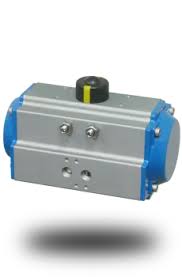In industrial sectors like oil & gas, chemical processing, and power generation, precise control of valves is critical for operational efficiency, safety, and reliability. Pneumatic double-acting actuators have emerged as a preferred choice in these industries due to their robust design, efficient performance, and adaptability to demanding environments. This article explores the working principle, applications, advantages, and key considerations for pneumatic double-acting actuators in these crucial industrial sectors.
What Are Pneumatic Double-Acting Actuators?
A pneumatic double-acting actuator is a mechanical device that uses compressed air to move a valve or other equipment in two directions: opening and closing. Unlike single-acting actuators, which use air pressure to move in one direction and a spring to return, double-acting actuators rely on air pressure to control movement in both directions. This feature provides greater control and flexibility in valve operation, making them ideal for critical industrial processes.
The actuator typically consists of a cylindrical chamber with two air ports—one on each side of a piston. Pressurized air is alternately applied to these ports, causing the piston to move back and forth, which in turn rotates or slides the valve stem. This mechanism allows for precise and repeatable valve positioning, essential in industries where accuracy and reliability are paramount.
Importance in Oil & Gas Industry
The oil and gas industry deals with highly volatile substances under extreme pressure and temperature conditions. Valves used in pipelines, refineries, and processing plants must operate flawlessly to ensure safety and prevent environmental hazards.
Double-acting pneumatic actuators are preferred in this industry because they offer:
Reliable Operation Under High Pressure: The ability to exert force in both directions ensures tight shutoff and smooth valve cycling, reducing the risk of leaks.
Fast Response Times: Pneumatic actuation allows quick valve movement, essential during emergency shutdowns or process adjustments.
Fail-Safe Flexibility: In critical applications, double-acting actuators can be integrated with control systems to respond rapidly to changing operational demands.
For example, in upstream oil extraction, these actuators control flow valves that manage the movement of crude oil and gas from wells to processing units. Precise valve actuation maintains pressure balance and flow rates, optimizing extraction and transportation.
Role in Chemical Processing Plants
Chemical plants often handle corrosive, toxic, and flammable substances, requiring highly reliable valve control systems to prevent leaks and spills. Pneumatic double-acting actuators are widely used here due to their:
Chemical Resistance: Many actuators are made with materials or coatings that resist corrosion from harsh chemicals.
Precision Control: Accurate positioning reduces the risk of over- or under-dosing reactants, ensuring consistent product quality.
Safety Compliance: Pneumatic systems are intrinsically safer than electric actuators in explosive environments because they do not generate sparks.
These actuators operate various valves, including ball, butterfly, and plug valves, in reactors, storage tanks, and pipelines. Their dual-pressure operation helps maintain tight sealing, critical to avoid contamination and hazardous leaks.
Application in Power Plants
Power plants, whether fossil fuel, nuclear, or renewable, require efficient valve control for steam, water, and fuel flow. Pneumatic double-acting actuators are preferred for their:
Durability in Harsh Conditions: They withstand high temperatures and continuous operation cycles common in power generation.
Energy Efficiency: Using compressed air as a power source reduces electrical consumption and lowers operational costs.
Enhanced Control: The ability to modulate valve positions supports fine-tuned process control, improving plant efficiency and safety.
In thermal power plants, these actuators manage steam valves that regulate turbine operation. Precise valve actuation ensures optimal steam flow, which directly impacts power output and fuel efficiency.
Advantages of Double-Acting Pneumatic Actuators
-
Bidirectional Force: Unlike spring-return actuators, double-acting types use air pressure to move valves both ways, offering greater control and torque.
-
Higher Reliability: Absence of springs means fewer mechanical failures and consistent performance over long periods.
-
Fast and Accurate Operation: Enables quick valve positioning with minimal delay, essential in emergency or dynamic processes.
-
Adaptability: Can be used with various valve types—ball, butterfly, plug, and globe valves.
-
Safety: Pneumatic operation is safe in explosive and hazardous environments since it avoids electrical sparks.
-
Ease of Maintenance: Simpler design with fewer moving parts allows easier servicing and lower downtime.
Key Considerations When Selecting Double-Acting Pneumatic Actuators
To maximize performance and longevity, choosing the right double-acting actuator involves evaluating:
-
Torque Requirements: Ensure the actuator provides sufficient torque to operate the valve under maximum pressure and temperature.
-
Material Compatibility: Select actuator materials compatible with the process media to resist corrosion and wear.
-
Operating Pressure: Match actuator design to the available compressed air pressure for optimal function.
-
Environmental Conditions: Consider factors such as temperature extremes, humidity, and exposure to chemicals or dust.
-
Control Options: Integration with positioners, limit switches, and feedback devices can enhance automation and monitoring.
-
Safety Features: Explosion-proof or flameproof models may be necessary for hazardous locations.
Installation and Maintenance Best Practices
Proper installation and regular maintenance are vital to ensure reliable actuator performance:
-
Correct Alignment: Misalignment can cause wear and premature failure; actuators should be installed according to manufacturer guidelines.
-
Air Quality: Clean, dry, and filtered compressed air prolongs actuator life by preventing contamination and corrosion.
-
Periodic Inspection: Check seals, piston movement, and air ports for leaks or damage.
-
Lubrication: Some actuators require periodic lubrication of moving parts.
-
Functional Testing: Regularly test actuator response and valve positioning to detect issues early.
Conclusion
Pneumatic double-acting actuators are indispensable components in oil & gas, chemical, and power plants. Their ability to provide precise, reliable, and safe valve operation under demanding industrial conditions makes them a cornerstone of process automation. By selecting the right actuator type and adhering to best practices in installation and maintenance, industries can optimize performance, reduce downtime, and ensure safety in critical operations.







